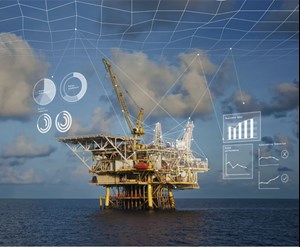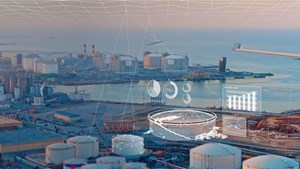Unlocking the hidden value of data with a unified digital twin
The upstream oil and gas sector has benefitted from mining data sources to improve its exploration and production operations over the past decade. However, despite the wealth of data that is at its disposal, the sector has been lagging other more progressive industries when it comes to maximizing the potential of that repository to extract maximum business value.
In its 2017 Digitization and Energy report, the International Energy Agency estimated that digital technologies could cut production costs by as much as 20%. It is a sentiment that PWC echoed a year later in its Drilling for Data report, when it conservatively estimated that use of digital technologies in the upstream sector could result in cumulative savings in capital expenditures and operating expenditures of $100 billion to $1 trillion by 2025, Fig. 1.

The answer lies in the incremental nature of transformation within the sector, with digital initiatives being adopted in silos to meet specific operational needs, whether it be seismic acquisition and processing, drilling or production. These proprietary solutions delivered excellent results, but the data collected remained locked in the application, available only to the users and often unavailable to other teams, thus reducing the possibility of delivering data-driven value at scale.
Some problems that manifest with proprietary systems is that they have their data models, their data requirements, their workflows and reporting capabilities. With a digital twin, we are attempting to elevate that data up into a unified context to allow users to benefit from the best of both worlds. Operators can leverage the investment made in specialist systems while recognizing that to drive change, it must be cross-functional with the information unified and in context.
DIGITAL TWIN
The path that the industry is taking to unlock and unify these often-disparate pools of data is in the form of the digital twin. The term digital twin, itself, requires some elucidation, as the term has been utilized by many vendors to describe any form of digital visualization. If you look across the vendor and operator landscape, some use the term purely to refer to information repositories. This often involves a 3D or 2D representation of the facility, with corresponding documentation that is fed with data from the IT platform. But it’s still a static representation of the facility, a snapshot in time.
Kognitwin technology. At Kongsberg, we have a rich heritage within the industry, so we come at this situation from a process and physics-based perspective. We leverage that experience to build dynamic digital twins that incorporate strong integration and collaboration elements, infused with AI and ML capabilities. Definition-wise, to us, a digital twin is a full virtualization of the facility, describing its current state and behavior, and that is what we have achieved with Kognitwin, Fig. 2. It includes the transcendent behavior of the facility in its environment, leveraging the information that is collected to describe the current situation and predict how the facility or asset will behave in its environment over time. To achieve this, we leverage the integration of dynamic simulation and more broadly, we integrate data from both the operational technology (OT) and information technology (IT) platforms, along with proprietary platforms that companies have invested in, to enable a fully virtualized view into their facility portfolio.

The Kognitwin is alive and reflects the behavior in real-time, integrating both the real-time data that describe the action of the facility and simulation capabilities, and the complete information architecture surrounding the asset. This can include the engineering data, such as different types of diagrams that engineers use to interact with the facility. We ensure that this is all collected, contextualized and represented in a current state.
With this unified and visualized data source, it will become the one version of the truth. It will be where anyone throughout the value chain—seismic engineer, control engineer, driller, process engineer or manager of the facility or process—can go to see the information. The ambition is that this becomes the number-one source to access information about the asset, but also to go further than that and understand its behavior, drive scenario modeling and allow users to optimize the asset performance.
Because it is a mirror image of the facility, it must consider all the aspects of the operation from an IT and OT perspective. To , it requires a streamlined way to bring that data online and a scalable architecture that allows it to be scaled across the asset portfolio. With all this information in one context, it can be delivered through the Cloud onto devices that can be accessed remotely in a collaborative setting, Fig. 3.

This digital twin reflects the challenges in the industry, where decisions are currently not always as data-driven as they could be. Information is inherently still trapped within the functional silos of the companies, and we are working hard to address those points with this offering.
SHELL CASE STUDY
One company that has recognized the value delivered by digital twins is Shell. The Anglo-Dutch multinational operates in one of the most challenging engineering and operational sectors. Shell has long been a pioneer in the digital transformation within the energy sector. As part of this evolution, late last year the firm signed an enterprise agreement with Kongsberg Digital for digital twin software to be deployed across its assets and capital projects.
This is not the first time that Shell has worked with Kongsberg Digital and utilized the innovative digital twin technology; this occurred two years ago at the Shell Nyhamna gas processing plant (Norway). Natural gas from the Ormen Lange deepwater field, offshore Norway, first arrives onshore at the plant, where impurities are removed, then it is piped to the UK. The recent Nyhamna Expansion upgraded the plant to receive gas from more fields through a new pipeline, allowing it to supply enough gas for up to 22 million European homes.
In October 2019, Norske Shell—together with Gassco and the Nyhamna and Ormen Lange partnerships—joined forces with Kongsberg Digital to operationalize an “asset of the future” through a partnership development of the Nyhamna Dynamic Digital Twin. The twin was developed in less than 100 day. Since January 2020, it has been in operation and evolving continuously through monthly product releases, focusing on safe, effective and integrated work processes, and optimization of production and energy use.
The Nyhamna Dynamic Digital Twin is a dynamic virtual representation of the gas facility and its behavior, updated continuously with integrated information reflecting the facility’s status in real time. The twin is supporting Nyhamna staff to better leverage insights from big data, transform ways of working to unlock value and increase resilience in a changing business environment. The digitalized version of the asset also provides the capability to simulate scenarios to uncover new options for optimization of its real-life counterpart, Fig. 4. The digital twin is used by an integrated team spanning all disciplines. During the twin’s first year, focus has been centered around embedding work process in the digital twin eco-system, and developing and implementing machine learning applications used for prediction and optimization.

“In the first year of using the digital twin, the Nyhamna teams, together with our partner, Kongsberg Digital, developed use-cases with a full line of sight to reducing our operating cost by about $3 million, which actually beats the investment cost,” said Rolf Einar Sæter, business improvement and technology manager at Norske Shell. “This is just the start of our digital transformation journey.” The initial cost-savings enabled by the dynamic digital twin represent work process improvements, reduced IT costs, and improved efficiency in execution of activities and optimization related to energy use.
The dynamic digital twin enables Shell to explore the operating envelope of Nyhamna under stable operation and in transitions between one operation scenario and the next. This provides a completely new way of optimizing energy and production, where the ultimate objective is to maximize gas and condensate production and minimize energy consumption while reducing maintenance need and avoid breakdown. By running “what if” simulations, the operations support team, together with the control room, can take faster and more accurate process change decisions. This will enable operational personnel to choose optimum plant configuration at all times, directly quantify the effects and thus increase Nyhamna’s competitiveness.
According to Norske Shell, the collaborative approach combining Kongsberg Digital’s digital capabilities with its employees’ operational expertise is proving to be a winning formula. The Nyhamna dynamic digital twin is empowering the teams to become more effective and collaborate even better. This enables Norske Shell to increase safety, optimize energy use and deliver higher margins to all the Nyhamna partners.
Going subsea. Following on from the successful application at Nyhamna, the next step is to scale the dynamic digital twin technology to include Ormen Lange field, including all offshore infrastructure. Ormen Lange is Norway’s second-largest gas field and has been developed with four subsea templates. It sits in 1,000 m of water in the Norwegian Sea, with all gas produced transported by a 120-km pipeline to Nyhamna for onshore processing. Through this digitization, Shell will be able to maximize recovery, optimize production and reduce environmental footprint. When they complete the process, the entire value chain of the field will be integrated in the twin environment to deliver a reservoir-to-market dynamic digital twin.

- Transforming challenging well production through advanced engineering (December 2025)
- Industrial Intelligence: At Weatherford, data drives the bit and everything after (October 2025)
- CygNet enters a new chapter of evolution (September 2025)
- How AI can close the digital delta and transform legacy oil and gas operations (September 2025)
- Unlocking the true potential of FPSO operations with a contextual digital twin (August 2025)
- Smarter well interventions accelerate productivity (July 2025)
- Subsea technology- Corrosion monitoring: From failure to success (February 2024)
- Applying ultra-deep LWD resistivity technology successfully in a SAGD operation (May 2019)
- Adoption of wireless intelligent completions advances (May 2019)
- Majors double down as takeaway crunch eases (April 2019)
- What’s new in well logging and formation evaluation (April 2019)
- Qualification of a 20,000-psi subsea BOP: A collaborative approach (February 2019)


